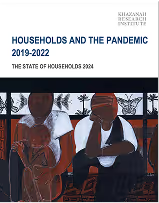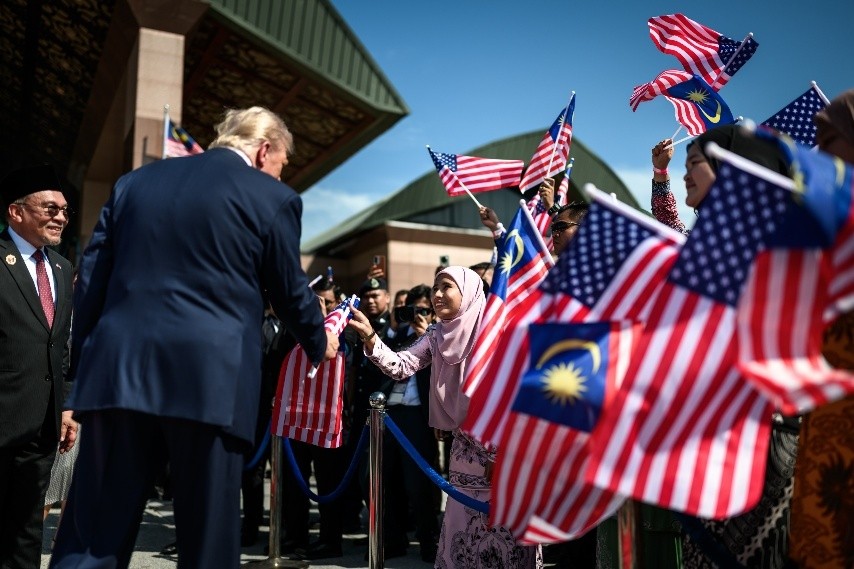
This View is Part 3 of a three-part analysis of the US-Malaysia trade deal. Part 1 looked at the new tariffs and industrial policy, while Part 2 looked at non-tariff measures.
Diplomatic Success, Economic Hedging
Diplomatic advances
The 47th ASEAN Summit has been hailed as a diplomatic success. A record number of world leaders attended the summit hosted by Malaysia in Kuala Lumpur. Underpinning ASEAN’s centrality and neutrality, this included countries currently at loggerheads with each other represented by US president Donald Trump, Chinese premier Li Qiang, Russian deputy prime minister Alexey Overchuk, Brazilian president Luiz Inácio Lulada Silva, South African president Cyril Ramaphosa, Japanese prime minister Sanae Takaichi, and European Council president António Costa.
Amidst sharpening US-China trade frictions, Malaysia’s famous hedging strategy, or active neutrality, was on full display. Much attention focused on the welcome lavished on Trump and his positive engagement with the Malaysian prime minister, including their participation in the formalisation of a peace deal between Thailand and Cambodia. Trump has set his sights on the Nobel Peace Prize and a number of US allies have fallen over themselves in offering to nominate him for the award. The Cambodia-Thailand peace ceremony provided a more dignified means of offering a piece of peace without resorting to nomination pledges.
In separate discussions, both Brazil and Russia suggested that Malaysia be upgraded to full membership in their Global South grouping BRICS from its current status as a BRICS partner country.
Malaysia also upgraded its diplomatic relationship with the US to a Comprehensive Strategic Partnership (CSP). A CSP is a relatively imprecise term in diplomacy but it marks a high degree of mutual cooperation in economic, technical and cultural areas. Malaysia and China have had a CSP since 2013. ASEAN and the US had previously established a CSP in 2022. The US and Indonesia followed suit in 2023, while the US and Vietnam inked one in 2024.
Trade deals
In addition to the Agreement Between the United States of America and Malaysia on Reciprocal Tariffs 2025 (USMART),Malaysia also announced the conclusion of free trade agreement negotiations with South Korea (MKFTA), while ASEAN and China signed an upgrade to the 2002China-ASEAN Free Trade Area (CAFTA) with nine additional chapters. CAFTA’s upgrade was announced the day after the signing of the USMART, despite the latter’s Article 5.3.3 which cautions Malaysia from entering into trade agreements with “a country that jeopardizes essential U.S. interests”. However, we should note that the USMART while signed, was not yet in force. It will only enter into force 60 days after an exchange of notifications following the completion of legal procedures.
Malaysia’s policy space, resulting balance of trade and economic prospects are rightly being debated in the case of the USMART. The debate has also been charged by the support the United States has provided to Israel in its pursuit of genocide in Gaza, as well as the unilateral coercive approach taken by Trump towards trade policy.
While the USMART has drawn the most attention from commentators and the public, a more balanced assessment of Malaysia’s external economic relations should take into account Malaysia’s overall commitments and concessions via MKFTA, CAFTA and USMART, on top of existing commitments in major trade deals such as the Regional Comprehensive Economic Partnership (RCEP) and the Comprehensive and Progressive Agreement for Trans-Pacific Partnership (CPTPP).
While initiated by ASEAN, RCEP is perceived as China-centric. The CPTPP was originated as part of the US Obama Administration’s attempt to contain China in the Asia-Pacific. After Trump withdrew from the Trans-Pacific Partnership (TPP) during his first presidency, Japan took ownership of the rebranded CPTPP.
The CPTPP has been a controversial policy topic in Malaysia for years, particularly due to its impacts on goods liberalisation, intellectual property, government procurement, state-owned enterprises, lack of preferential market access to the US (due to US withdrawal), and investment rules including potent investor-state dispute settlement (ISDS). Successive governments in the post-Najib era deferredratification until the Ismail Sabri administration moved to do so at the eleventh hour prior to elections.
Malaysian trade strategy
Malaysia’s trade strategy in the decades prior to the Trump tariffs has been to pursue liberalisation in goods and investment in the hope of:
i) securing increased trade via lower tariff rates than the baseline achieved in the World Trade Organisation (WTO);and,
ii) creating a domestic policy environment deemed more attractive to foreign investors (in light of FDI-dependency and a lack of globally-competitive large local firms).
To these ends, Malaysia has been willing to concede developmental policy space and certain domestic sectors, particularly manufacturing – in the hopes of achieving by treaty what, for example, East Asian countries have achieved by industrial policy. That trade policy should be complementary to domestic policies creating local firms that are robust at scale has sometimes been lost on policymakers in past decades. The connective policy tissue that would allow local suppliers to MNCs to eventually become their global competitors has not been successfully established.
Past attempts to reduce FDI dependence, voiced in the various 10-year industrial master plans since the first, have been frustrated by subsequent recessions or global financial crises. Crisis pushed past Malaysian governments away from bolder industrial policy back towards a more accommodative stance towards FDI as Malaysia competed with other global locations offering incentives in the proverbial ‘race to the bottom’[1].
New Industrial Policy Ambitions
Malaysia’s New Industrial Master Plan (NIMP) and the subsequent National Semiconductor Strategy (NSS) set forth an ambition for raising up globally competitive large local firms in the semiconductor sector. These would arise from a 50-year old domestic ecosystem largely built around catering to US and Taiwanese manufacturing giants, and toa lesser extent European and Chinese firms. The trade policies of the second Trump administration strike at the heart of this nascent national ambition. The growth of local semiconductor firms has been in symbiosis with their MNC partners.
Beyond the E&E sector, the US is a major market for Malaysian oscilloscopes, medical devices, furniture, videogames, and rubber gloves. Sudden rises in the relative costs of their goods could cost them income, jobs and market share in the US. Malaysian exports to the US total led RM161 billion in 2023, and RM199 billion in 2024, ahead of exports to China and exceeded only by Singapore (Table 1). Goods shipped to Singapore are typically traded on towards the US.
Table 1: Malaysia exports, top three partners, 2022-2024

A 25% tariff level is popularly perceived to be a level at which trade would grind to a halt, all other things being equal. In the case of other countries being Trump tariffed, the differential between 25% and 19% might incentivise companies to engage in tariff arbitrage and relocate production to Thailand (19%), Indonesia (19%) or Vietnam (20%).The collapse of trade with the US would have a disruptive effect on Malaysia, which often styles itself as a “trading nation”.
The government’s limited fiscal space would be further pressured if it were to resort to heavy borrowing to shore up a hollowed out manufacturing sector. But if access to the largest consumer market was closed off behind high tariffs, how would firms shift enough product in a small domestic market without leaning on exports for scale? Other developing countries and China lack sufficient demand to absorb such supply in the short term. Europe likewise is struggling after combined fuel, trade and austerity shocks. The lack of an alternative market in the short term does not mean that alternatives should not be explored in the long term.
While the USMART imposes multiple policy constraints, these constraints are only decisive if the government fails to turn them into a catalyst for long term resilience and strength. This policy ambition presently appears to be absent in Malaysian policy discussions about the USMART, NIMP ambitions notwithstanding.
An Industrial Policy Challenge
The Trump administration’s approach to trade policy is fundamentally unfair because it takes an iconoclastic view of reciprocity and has cast the old rules-based order of the WTO aside in favour of leveraging US market acess to extract greater trade and investment from other countries. Tribute is its way of making America great again.
In effect, the US trade policy share similar objectives to Malaysian trade and investment policy – trade more and court more foreign investment. However, Malaysia is far weaker with little economic, military or political coercive power to achieve such objectives.
Trump has also expressed the quixotic hope that his tariffs will induce manufacturing to relocate to the US. So far, the effect is indirect. Rather than relative prices sending signals for manufacturers to relocate to the US, it is outright demands for investment into the US backed by the threat of high tariffs that is doing so. Meanwhile, Trump has had to tackle blowback in the form of inflation created by his tariff policies. On 14 November 2025, Trump rolled back tariffs on over 200 food products, contradicting his earlier claims that tariffs were not affecting retail prices[2]. Such tariff rollbacks could send a signal that commodity-based countries could wait out the Trump tariffs if their exports represent fundamental consumer staples. But the question is, who will blink first and after how long?
The only country capable of establishing an effective counter bargain to the US has been China. Other countries have had engage in a mix of flattery and appeasement. On his recent visit to South Korea for the Asia-Pacific Economic Cooperation (APEC) meeting, Trump was gifted with a medal and a crown[3]. Switzerland gifted him a gold Rolex desk clock and an engraved gold bar.
Trump has gained a reputation for a mercurial approach towards trade policy, evidenced by his actions towards Canada a day before arriving at the ASEAN Summit. Trump took exception to an anti-tariff advert featuring Ronald Reagan run by the Ontario provincial government[4].He cancelled trade talks with Canada and imposed an additional 10% tariff on top of the 35% rate imposed on Canadian goods not covered by the United States, Mexico, Canada Agreement (USMCA). Canadian Prime Minister Mark Carney subsequently apologised to Trump.
This behaviour underlines a certain value in making a positive impression on Trump in the first year of his second presidential term. A positive impression now could serve as insurance against policy upsets later. Mexican president Claudia Sheinbaum has gained some acclaim for managing Trump better than her Canadian counterpart thanks to a firm but accommodative approach that earned a modicum of respect.
Only China has the strength and power to effectively counter US brinksmanship and escalation. It cannot escape our notice that this is a power primarily built on its industrial policy success in industries critical to US interests, such as processed rare earths.
Conclusion
The USMART is an unfair deal signed under duress. It should serve as a fresh reminder that a rules-based trading order was a fragile construct built upon a post-Cold War order and forced upon the world by Europe and the US. It is one that has crumbled with the rise of China and the industrial decline of the US and Europe.
There are no fair deals between the US and its trading partners. Even the present détente between China and the US is “unfair” from the perspective of the old rules-based order. But China has been able to leverage its strength to minimise the degree of unfairness. Malaysia and the rest of ASEAN cannot hope to reach China’s capabilities as a regional superpower. However, they can take lessons from China and its US-aligned East Asian neighbours, Japan and South Korea.
These countries ascended with a mix of cooperation and competition with the US. Where they succeeded best was in sharpening their competitiveness versus American industries, beating their auto industry, offering a robust alternative to smartphones, and threatening to eclipse their lead in semiconductors and artificial intelligence. Development can happen through economic ties with the US, but partners of convenience must be prepared to displace the US.
Financial and manufacturing strength are important tools for small countries to increase their influence and improve their positioning vis-à-vis regional and global superpowers. However, economic power will still confront fundamental limits imposed by population size and military power.
Out of these forms of power, economic power is the one that Malaysia can progress the most in. Strategic thinking should be focused on minimising sources of weakness and increasing pillars of strength. Now is the time to lay the foundations of trade diversification and a strong domestic industrialisation agenda to reduce the risk of trade and investment exposure to the caprices of US policy.















.avif)